Tubular capacitor with variable capacitance and dielectrically elongated inner electrode for NMR applications
a tubular capacitor and dielectrically elongated inner electrode technology, applied in mechanically variable capacitors, variable capacitors, magnetic measurements, etc., can solve the problem of limiting the quality of the resulting nmr spectra, achieve good nmr spectra, prevent high voltage sparkover, and facilitate clamping
- Summary
- Abstract
- Description
- Claims
- Application Information
AI Technical Summary
Benefits of technology
Problems solved by technology
Method used
Image
Examples
Embodiment Construction
[0039] Current NMR spectrometers almost exclusively use short RF pulses or precisely defined groups of RF pulses to excite the magnetic spins in the measuring sample. The resulting signal is called FID (Free Induction Decay) from which the desired NMR spectrum is subsequently calculated using fast Fourier transformation.
[0040] The measuring sample is excited using an RF resonator (RF=radio frequency) which is located within the NMR probe head, closely disposed about the measuring sample and tuned to the desired excitation frequency f0. The proton excitation frequency of today's NMR spectrometers is between 100 MHz and 900 MHz.
[0041] Short RF current pulses iL are fed into the RF resonator during the excitation process (FIG. 1). This produces short magnetic RF field pulses which excite the spin system.
[0042] The RF field pulses must be as short as possible in order to excite the overall NMR spectrum simultaneously and as uniformly as possible, and also have a sufficiently high RF ...
PUM
 Login to View More
Login to View More Abstract
Description
Claims
Application Information
 Login to View More
Login to View More - R&D
- Intellectual Property
- Life Sciences
- Materials
- Tech Scout
- Unparalleled Data Quality
- Higher Quality Content
- 60% Fewer Hallucinations
Browse by: Latest US Patents, China's latest patents, Technical Efficacy Thesaurus, Application Domain, Technology Topic, Popular Technical Reports.
© 2025 PatSnap. All rights reserved.Legal|Privacy policy|Modern Slavery Act Transparency Statement|Sitemap|About US| Contact US: help@patsnap.com



